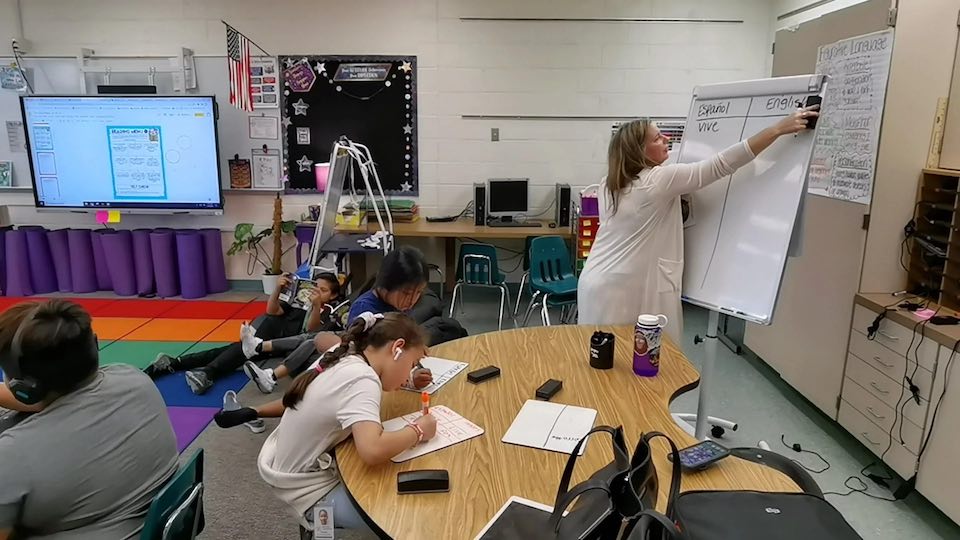
How to Support ESL Students in the Classroom?
Jose, a junior high school student from Mexico, was originally a high achiever in his home country, but when he came to his new school in the US, he found that he couldn't understand the teachers and had a hard time keeping up with the pace of the class. During lunchtime, he often sat alone in a corner because he didn't know how to communicate with his classmates in English. Once in a history class, the teacher asked him a question, and because he was nervous and couldn't understand the question, he stood still and was silent for a long time, and finally sat down with his head bowed. At that moment, he felt so ashamed and lonely that he even began to wonder if he really belonged in the class. For him, the language barrier not only affected his studies, but also made him feel emotionally out of place.
English as a Second Language (ESL) students bring unique perspectives and diversity to the classroom, but they face the challenge of adapting to a new academic and cultural environment while learning English. Whether you are a teacher or parents of ESL students ,understanding how to effectively support ESL students is critical to their academic success and self-confidence building.
ESL students, also known as English Language Learners (ELLs), are people whose first language is not English. Their level of English proficiency varies from beginners with limited English proficiency to advanced learners who are improving their language skills. According to the U.S. Department of Education, there are more than 4.8 million ELL students in the U.S. alone, and this number continues to grow.

Understanding the ESL student experience: it's not just about the language
Before we get into specific strategies, it is important to first recognize that ESL students' challenges in the classroom are multifaceted, while they also possess unique strengths and potential.
The “Silent Period”
Many ESL students go through a “silent period” at the beginning of their language acquisition - they are actively listening and understanding, but have not yet begun to express themselves in the new language. This is a natural stage of language acquisition and should not be mistaken for a lack of understanding or participation.
Cognitive Load (Cognitive Load)
Learning subject matter in a non-native environment significantly increases a student's cognitive load. Imagine trying to solve a complex math problem while struggling to understand the instructions in English, that's a huge challenge for anyone.
Cultural Adjustment
ESL students not only face language challenges, but also have to adapt to new cultural norms, social rules, and teaching systems. This cultural shift often triggers stress, which can affect their concentration, engagement, and even emotional state.
Differences in Educational Background (Prior Educational Background)
ESL students come from a variety of educational backgrounds. Some may have little to no formal education, while others have excelled in their native language. Understanding their established knowledge base helps to accurately support their learning.
Resilience and Strengths
Above all, it is important to recognize the resilience of ESL students. They are often highly motivated and possess a strong intellectual curiosity, problem-solving skills, and bring unique cultural insights, all of which add to the richness and diversity of the entire classroom.
Practical Strategies for Supporting ESL Students in the Classroom
Suggestions for ESL Program Teachers:
1. Create a Welcoming and Inclusive Classroom
Use Visual Aids: Label items in the classroom in English and in the students' native language (if feasible). Use diagrams, flow charts, and objects to help students understand concepts.
Buddy System: Pair ESL students with a friendly, English-speaking peer in the classroom who can help with daily activities, explain classroom instructions, and provide social support.
Cultural Sensitivity: Understand students' cultural backgrounds. Display multicultural books, artwork, and instructional materials in the classroom. Celebrate different cultural holidays and traditions to demonstrate respect and diversity.
Pronunciation Practice: Be patient and encouraging in pronunciation. Demonstrate correct pronunciation in a clear manner while providing students with opportunities to practice without embarrassment or fear of being judged for mispronunciation.
2. Differentiated Instruction for Language Development:
Pre-Lesson Vocabulary Instruction: Introduce key vocabulary words in advance of the formal lesson. Use pictures, gestures, and clear, simple English explanations to help students understand. Write new vocabulary on the board to reinforce memorization.
Simplify language: Use shorter sentences and avoid complex grammatical structures or English idioms at the outset. Speak at a moderate pace and pronounce words clearly to help students understand better.
Repetition and rephrasing: Don't worry about repeating your instructions or explanations. Rephrasing questions in different ways helps students understand the content from multiple perspectives.
Provide Sentence Guides and Templates: By providing sentence starters (e.g., “I think ......,” "The main idea is ...... “, ”The main idea is ......“, ”Because ......") to encourage students to engage in discussion and writing, increasing confidence and accuracy of expression.
Use graphic organizers: Use graphic learning tools (e.g., KWL charts, Venn diagrams, concept maps, etc.) to help students sort through information and make connections between concepts.
Use teaching aids and hands-on activities: Use physical teaching aids and hands-on activities to enable students to engage with and understand content in a more concrete, interactive way.
3. Facilitate Comprehension and Participation:
Check for Understanding Frequently: Don't just ask, "Do you understand?" Instead, ask open-ended questions that require more than a yes/no answer (e.g., "Can you tell me in your own words...?").
Allow time for reflection and response: Giving ESL students more time to think about the question and organize their response without rushing them reduces stress and encourages more confident expression.
Utilize Technology: Language learning apps, online dictionaries and translation tools are valuable resources. Digital textbooks with voice-over capabilities can be used to help students better understand the content.
Meanwhile, Timekettle also offers translation products designed for classroom communication, such as the X1 AI Interpreter Hub which helps ESL students break down language barriers in the classroom by communicating more smoothly with teachers and classmates. If you're interested, check out the article below to see how Timekettle provides tailored solutions for ESL learners:
- Emergent Bilingual Students Find Their Voice With Real-Time Translation
- How to Use AI Translator Earbuds to Overcome Language Barriers in Education
Emphasize communication over perfection: In the early stages, prioritize encouraging communicative expression over over-correcting grammatical errors. Every attempt to express oneself deserves to be recognized and encouraged.
Suggestion for Parents
1. Maintain and Value the Home Language:
Maintaining the mother tongue is essential for the child's cognitive development and the maintenance of family bonding. In turn, a strong foundation in the mother tongue helps children learn English better.
Read Books in Your Native Language: Reading together in any language builds literacy skills.
Share Cultural Stories and Traditions: helps children maintain a sense of identity and belonging to their culture.
2. Communicate Effectively with the School and Teachers:
Establish contact as early as possible: Contact your child's teacher at the beginning of the school year to establish lines of communication.
Ask questions: Don't hesitate to ask questions about school policies, your child's schooling, etc.
Utilize Interpreter Resources: Request interpreter services for parent-teacher conferences or other important meetings if needed.
Share Important Information: Inform teachers about your child's past learning experiences, special learning needs or cultural background so that they can better understand and support your child.
Keeping Information Synchronized: Ask if the school has a newsletter, online portal, or home-school communication app to keep up to date with school news and your child's performance.
3. Support Language Learning at Home:
Create a Language-Rich Environment: Talk to your child about their day, objects around the house, and everyday activities.
Read English Books Together: Start with picture books and gradually move to more complex texts. Point to words as you read.
Listen to English Songs and Watch English Shows: Children's programs and songs can be excellent tools for language exposure.
Practice English in Everyday Situations: Role-play ordering food at a restaurant, asking for directions, or making simple purchases.
Encourage Social Interaction: Encourage your child to play with English-speaking children in your neighborhood or through extracurricular activities.
Conclusion
Supporting ESL students in the classroom is a journey of understanding, patience, and dedication. By implementing effective strategies, fostering open communication, and celebrating every step of their progress, teachers and parents can empower these remarkable students to not only master a new language but to excel academically and socially. Remember, every ESL student brings a unique light to the classroom, and with the right support, that light can shine brilliantly, enriching the learning experience for everyone.

























